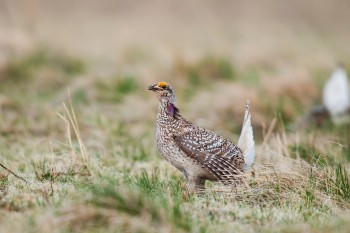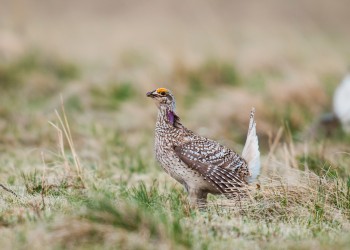Grouse Gatherings in the Grasslands
The Dakota Prairie Grasslands wildlife biologists monitor three species of prairie grouse, including sharp-tailed grouse, greater sage-grouse, and greater prairie chickens at communal breeding grounds called leks, a specific type of mating arena where males of a species gather and display to attract females. Lekking is the behavior of males congregating at these locations for mating. Males compete for females at a centralized display site, exhibiting courtship behaviors, including dancing, strutting, and sometimes sparring with other males to establish dominance. The photo gallery below illustrates these mating rituals.
Click an image to view the photo gallery in full-screen size and read the descriptive captions.
Sharp-tail Lekking in the Grasslands
Figure 1. Female sharp-tailed grouse are similar in appearance to males but lack the males' conspicuous purple air sacs and yellow eyebrow combs. They are characterized by their mottled brown and gray plumage, with white underparts and V-shaped markings. Their tail feathers are shorter and pointed, with a slightly crested head.
(Licensed photo by BGSmith/Adobe Stock photo.)The sharp-tail grouse are a management indicator species for the Dakota Prairie Grasslands. An indicator species is an organism whose existence, absence, or overabundance reflects a specific environmental condition. Indicator species can signal a change in the biological condition of a particular ecosystem and can be used as a representative to analyze and gauge that particular environment's health.
Sharp-tail grouse, often referred to as sharpies, are among many species that rely on diverse vegetative structures within the area's mixed grass prairie. Sharpies are medium-sized gamebirds closely related to lesser and greater prairie chickens, but they have a longer, white-edged, wedge-shaped tail with two long central feathers, giving them a drawn-out, spiky appearance. Sharp-tails also have white spots on their backs and wings.
Additionally, males of both prairie chicken and sharp-tail species have vibrant inflatable air sacs or drum napes on either side of their necks. Sharp-tail's drum napes are purple, and the Greater prairie-chickens sacs are yellow-orange. These vivid pouches are extensions of their esophagus and are more than ordinary ornamentation; they advocate their overall healthiness and virility to potential mates. Aside from the drum napes, the two sharp-tails' sexes look similar though the pattern on their central pair of tail feathers differs. Males have longitudinal stripes, whereas females feature a crossbar pattern (Figure 2).
Figure 2. Sharp-tailed Grouse (Tympanuchus phasianellus). A medium-sized bird with a stocky, oval-shaped bird with a small head, a sharply pointed, light-colored tail, mottled brown and gray plumage, a pointed tail, and white spots on their wings. Males have yellow eyebrows and inflatable lavender air sacs on their necks.
(Licensed photo by Stan/Adobe Stock photo. )
The sharp-tail territorial distribution stretches farther north than that of their prairie-chicken cousins, and they have developed special adaptations for these much colder climates. Akin to their north-ranging relative, the Ruffed Grouse, the sharpies developed feathered nostrils and legs to keep them warmer, aiding them in surviving the snowy season's frigid temperatures.
Furthermore, they have comb-like projections called pectinations protruding from their toes. These protuberances act as snowshoes, allowing them to walk on top of snow-covered surfaces and to roost comfortably on snowy branches. Sharp-tailed grouses may also burrow into the snow at night for extra warmth.
The preferred sharpie habitat includes grasslands and prairies interspersed with dense shrubs (in the southern range), bog edges, and shrubby openings in the boreal forests (in the northern part of the range). Winter habitats usually include croplands and areas with taller shrubs and trees to protect them from the blustery winds and bitter cold. They shuttle between roosting and feeding areas, which can be several miles apart. Sharp-tailed grouse forage on both the ground and in trees. On the terrain floor, they peck at seeds, grains, and insects; in trees, they feed on buds, flowers, and berries.
In early April, male and female sharpies gather on open clearings surrounded by sagebrush cover called leks. Lekking is when the males engage in elaborate courtship displays to attract female attention. For two shows a day, in the early morning and evening, males converge to perform their courtship dance.
Male grouse also display aggressive behaviors toward one another, frequently fighting for female fancies by using their beaks, claws, and wings to attack each other (Figure 3). Other assertive exhibitions include affecting postures and warbling calls like chiik and chaw notes. To human ears, it sounds like squealing, whining, and gobbling.
However, the tail-rattling exhibition is the most intricate sharpie mating balletic presentation. It consists of rapid stepping motions with the tail erect, the head held forward, and the wings outstretched. Once assuming this hyperextended stance, the male rhythmically moves in a small circle or arc, and vibrating his tail feathers, making clicking or rattling sounds. Males often perform tail rattling synchronously with other bachelors, frequently stopping to pose before the females.
Also common is a cooing presentation, which resembles the booming of the greater prairie chicken in which the sharpie cocks his tail, lowers his head, and inflates his esophagus to make a low-pitched cooing sound.
Figure 3. Male sharp-tailed grouse engage in intense, territorial battles on their leks, often called dancing grounds, as part of their courtship rituals. These displays involve various physical interactions, including pecking, feather-pulling, wing beating, and even jumping or chest-bumping. The dominant male aims to maintain control of the lek's center, and other males challenge this dominance through these aggressive behaviors.
(Licensed photo by Stepan/Adobe Stock photo.)When the male successfully attracts a female, they mate, and then the female returns to her pre-prepared nest site, usually within one-half mile of the lek site in a grassy opening with scattered brush. She lines a nest scrape with down (feathers) and lays one egg daily until the clutch of 10-14 eggs is complete. The eggs are a drab olive color with fine reddish-brown speckles. Typically, they produce a single clutch annually but may produce a second brood if their first clutch is destroyed.
Females incubate the eggs for about 23 or 24 days. Following hatching, the brood remains in grass and brushland cover, consuming insects and plants until they can take wing in about ten days. By six to eight weeks, they begin to disperse, fully independent of their mother and relocating several miles from their hatch sites.
Fun fact: Sharp-tailed grouse were an important source of food for Native Americans, and elements of the birds' spring breeding display are incorporated into the traditional dances of some Native American tribes. Some dances, such as the Grouse Dance of the Northern Tutchone people, are still practiced today.












